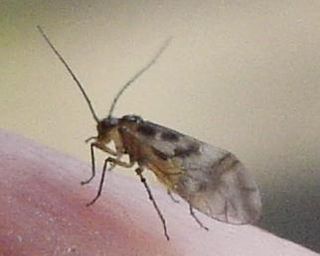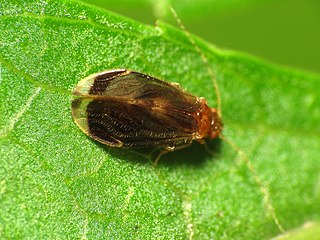
Psocoptera are a paraphyletic group of insects that are commonly known as booklice, barklice or barkflies. The name Psocoptera has been replaced with Psocodea in recent literature, with the inclusion of the former order Phthiraptera into Psocodea.

Psocomorpha is a suborder of barklice, booklice, and parasitic lice in the order Psocodea. There are more than 20 families and 5,300 described species in Psocomorpha.

Trogiomorpha is one of the three major suborders of barklice, booklice, and parasitic lice in the order Psocodea, alongside Troctomorpha and Psocomorpha. There are about 8 families and more than 430 described species in Trogiomorpha. Trogiomorpha is widely agreed to be earliest diverging of the three suborders, and retains the most primitive characteristics.

Troctomorpha is one of the three major suborders of Psocodea (barklice, booklice, and parasitic lice), alongside Psocomorpha and Trogiomorpha. There are more than 30 families and 5,800 described species in Troctomorpha. The order includes parasitic lice, which are most closely related to the booklice family Liposcelididae.

Amphipsocidae is a family of hairy-winged barklice in the order Psocodea. Most species are 3.0-4.5 mm long and have many setae (hairs) on the veins and margin of the forewing. The main veins of the forewing are usually lined with two rows of setae. Like the other members of the infra-order Caeciliusetae, they have a broad, flat labrum, with well defined edges.

Caeciliusetae is an infraorder of Psocodea in the suborder Psocomorpha. There are about 6 families and more than 1,300 described species in Caeciliusetae.
Asiopsocidae is a family of Psocodea belonging to the infraorder Caeciliusetae. The family is composed of 14 known species of barklice in three genera: Asiopsocus, Notiopsocus, and Pronotiopsocus. One species from each genus has been found in the United States.

Peripsocidae is a family of Psocoptera belonging to the suborder Psocomorpha. Members of the family are characterised by their absence of an areola postica in their wings. Many of the recently described genera are closely allied to Peripsocus. The family includes more than 300 species.
Archipsocidae is a family of barklice of the order Psocodea belonging to the suborder Psocomorpha. Members of the family are characterized by their reduced wing venation. Some species are viviparous. The family includes about 80 species in five genera.

Caeciliusidae is a family of Psocodea belonging to the suborder Psocomorpha. The family was once named Caeciliidae, but the latter name was changed because of homonymy with the amphibian family Caeciliidae. The subfamily Paracaeciliinae was formerly in Caeciliusidae, but it has been elevated to family rank, Paracaeciliidae.

Homilopscocidea is an infraorder of Psocoptera. It is probably a paraphyletic group, still in use for lack of a better solution. There are about 7 families and more than 1,200 described species in Homilopsocidea.
Dasydemellidae is a family of Psocodea belonging to the suborder Psocomorpha, in the infraorder Caeciliusetae. The family is composed of about 30 species.
Ptiloneuridae is a family of Psocodea belonging to the suborder Psocomorpha. Like the other members of the infraorder Epipsocetae, they have a labrum with two sclerotized ridges.
Dolabellopsocidae is an insect family of Psocodea belonging to the suborder Psocomorpha, that includes the genera Isthmopsocus, Dolabellopsocus, and Auroropsocus. Like the other members of the infraorder Epipsocetae, they have a labrum with two sclerotized ridges. The family, which contains more than 40 known species, was first identified by Eertmoed in 1973.
Epipsocidae is an insect family of Psocodea belonging to the suborder Psocomorpha, that includes, among others, the genera Bertkauia, Epipsocus, Epipsocopsis, Goja, and the New Guinean endemic Dicropsocus. It includes 16 genera with more than 140 species. The only European species in the family is the apterous Bertkauia lucifuga. Like the other members of the infraorder Epipsocetae, they have a labrum with two sclerotized ridges. Epipsocids are barklice found primarily in tropical regions, and one of their distinguishing characteristics is the hairy ventral surface of the forewing.

Psocodea is a taxonomic group of insects comprising the bark lice, book lice and parasitic lice. It was formerly considered a superorder, but is now generally considered by entomologists as an order. Despite the greatly differing appearance of parasitic lice (Phthiraptera), they are believed to have evolved from within the former order Psocoptera, which contained the bark lice and book lice, now found to be paraphyletic. These insects first appeared in the Permian period, 295–248 million years ago. They are often regarded as the most primitive of the hemipteroids. Psocodea contains around 11,000 species, divided among four suborders and more than 70 families. They range in size from 1–10 millimetres (0.04–0.4 in) in length.

Epipsocetae is an infraorder of psocids in the order Psocodea. There are about 5 families and more than 480 described species in Epipsocetae.

Paracaeciliidae is a family of bark lice in the order Psocodea. There are about 5 genera and more than 100 described species in Paracaeciliidae.
Sabulopsocidae is a family of lice in the order Psocodea. There are at least two genera and two described species in Sabulopsocidae.
Spurostigmatidae is a family of lice in the order Psocodea. There is at least one genus, Spurostigma, in Spurostigmatidae.









